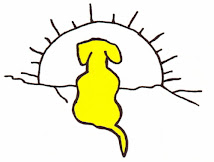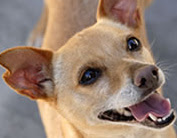I'm off to a trade show in Las Vegas today, but I first had to share my latest press release. I've been blogging about my new interactive dog training game and how it's
great for dogs of all ages and skill levels - not to mention it's
fun for both you and your dogSo please check out my our new press release and feel free to pass it along to anyone you think might be interested in this positive solution to dog training!
Inquisitive Canine’s Interactive Dog Training Game is Fun and Rewarding for Both Owner and Dog
Developed by distinguished dog trainer Joan Mayer, the Out of the Box Dog Training Game is an easy, simple and enjoyable way for you and your dog to play your way to canine good manners!Ventura, CA - With 39% of U.S. households owning at least one dog, the common reality for many people today is that they just don’t have the time, money, or energy to invest in dog training or coaching their dogs to develop and maintain good manners.
The Out of the Box Dog Training Game was developed by acclaimed
dog trainer and behavior coach Joan Mayer as a practical and affordable way for pet owners to positively reinforce real-world manners in their dogs while helping them create stronger bonds with their dogs for life.

This
positive dog training solution was designed to go beyond traditional dog obedience training by emphasizing the importance of understanding canine behavior so that dog owners can successfully reinforce the behaviors they want, while limiting and preventing inappropriate habits.
“This interactive
dog training game is highly effective because it employs established dog training techniques that reward and motivate both owner and dog,” said Mayer, founder of The Inquisitive Canine in Ventura. “I’ve created this
pawsitive dog training solution as an easy, simple, and enjoyable way for dog lovers to raise a healthy and happy pet. By making dog training fun, you and your dog are learning - and you don’t even know it!”
The Out of the Box Dog Training Game includes:
- 56 activity cards that address real world manners such as loose leash walking, doorbell etiquette, techniques for building confidence and enhancing socialization, and activities that fulfill a dog’s innate needs while helping them adapt to our human environment
- An 18-page Guide Booklet that includes everything from dog training technique instructions to tips on which rewards will best motivate your dog to learn
- Scorecard to help you and your dog play your way to canine good manners
“The game is designed for dogs of all ages and can be played just about anywhere and at anytime that works in your daily routine - making dog training less overwhelming and more enjoyable,“ said Mayer, who also authors the dog advice column
Dear Inquisitive Canine. "Since each
dog training activity can be customized for specific needs and adapted to different learner levels to help advance your dog’s skills, the game is different every time you play!”
The Out of the Box Dog Training Game can be purchased online at http://www.inquisitivecanine.com/dog-training-game.php
The Inquisitive Canine is dedicated to empowering dog owners with a rewarding education that will help them further develop and enhance their everyday relationships with their dogs. The Inquisitive Canine specializes in dog training methods that focus on understanding canine behavior and teaching dogs through techniques that reward and motivate. For more information on private dog training, group classes, virtual dog training or the Out of the Box Dog Training Game, please visit http://www.Inquisitivecanine.com/ or call (805) 650-8500.
Also, please visit our web site to check out more
news from the Inquisitive Canine.







